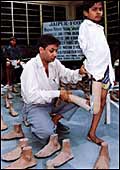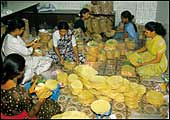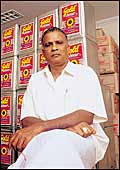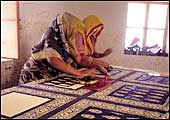|
"Good ideas," General
Electric's legendary former CEO Jack Welch once told BT, "are
meant to be borrowed." It wasn't merely a nifty soundbite.
Rather it was a one-line introduction to Welch's management philosophy
that had made the conglomerate one of the most successful in modern
corporate history. By trashing the "not invented here"
syndrome, Welch went on to borrow ideas from rival companies and
execute them better. For example, Six Sigma, a quality system made
famous by GE, was actually developed at Motorola. GE certainly did
not invent the internet but, after initial circumspection, has gone
on to adopt it to some wonderful effect.
That drives home another point about ideas.
You don't need to have the biggest R&D budget or the smartest
scientists to come up with inventions, systems or practices that
change the world. Sometimes, patience and adversity can be potent
crucibles too. Especially if you are talking of civilisations-like
India's. And when a civilisation has survived 9,000 years, there
are bound to be some clever ideas that contributed to its longevity,
never mind that today it is one of the world's most poor. So just
what are these ideas? There are at least 10 that we think the world
can take from India. These pertain to different aspects of the Indian
society, but each one of them meets two crucial criteria that every
successful idea must: One, it must have demonstrated efficacy and,
two, it must stand the test of time. Some of the ideas may be more
relevant to some countries than others. But that's another thing
about ideas: One must be smart enough to now which ones to pick,
and dedicated enough to make them work.
 |
| The Art of Living: Spirituality doesn't
have to be a serious business; it can, and should be fun |
SPIRITUALITY
Abiding Mystical Appeal
It's not so much about seeking god as
the peace within.
Even before garments,
diamonds, and software appeared on India's trade horizon, spirituality
was its biggest export. While it may not have fetched precious greenbacks,
it did give India its first brand identity. Whether it came via
Maharishi Mahesh Yogi's famous disciples from Liverpool, or via
the part-comical-part-controversial-but-mostly-misunderstood International
Society for Krishna Consciousness (ISKCON), is not really an issue.
Therefore, India as a global purveyor of spirituality is not a new
idea. What's new, however, is its renewed relevance in an era of
global terrorism, xenophobia, and economic uncertainty.
But does borrowing Indian spirituality mean
having to travel to India, donning a saffron robe, taking a dip
in the Ganges? Maybe not. For, the essence of spirituality is not
in the medium, but in transcending the immediacy of our daily lives;
realising that while it is one thing to do your best in whatever
you do, it's quite another expecting it to deliver the desired results.
If the idea is to acquire a measured detachment-realising that what's
a lifetime for you is, in the larger scheme of things, but a galactic
blip-then New York is as good as Rishikesh. However, if first-hand
experience is your preferred route to spirituality, you are welcome
to swing by India.
 |
| Jaipur Foot: It has a leg up on others |
LOW-COST QUALITY HEALTHCARE
Mother Necessity
It is possible to cure well for a pittance.
What's common to
an intra-ocular lens that costs $3, a prosthetic foot that costs
$28 to make, and a bypass surgery for less than $2,000? Besides
the unbeatable price proposition, two things: One, all of them are
Indian examples and, two, all of them match global quality. You
can get the ridiculously-priced intra-ocular lens at Aravind Eye
Hospital in Madurai; the cheaper-than-a-five-star-meal rubber foot
in Jaipur, and the steal-of-a-bypass surgery at any of Cardiac Research
and Education's (care) seven hospitals in the country. Is their
healthcare model replicable elsewhere? Perhaps not in countries
like the US, but in the poor countries of Africa, Eastern Europe,
and Asia, very much. What's at the heart of such a business model?
Ingenuity. At Aravind, systems borrowed from mass manufacturing
lower costs while preserving quality. At Bhagwan Mahaveer Viklang
Sahayata Samiti (or Jaipur Foot), department of irrigation pipes
replace more expensive materials as successfully, and at care doctor-owners
squeeze costs to make heart surgeries affordable. The interesting
bit about India's low-cost, high-quality healthcare: It's profitable.
 |
| Papad-power: The possibilities are endless |
COOPERATIVES
The Power Of Many
Self-organised businesses can become
an agent of change.
Year: 1959. Seven
women get together and start a papad-making business with a borrowed
capital of Rs 80. Today, their business-a cooperative called Sri
Mahila Griha Udyog Lijjat Pappad-has 42,000 members in 17 states,
and at last count raked in Rs 350 crore in sales. Rewind to the
early 40s. Dairy farmers in Gujarat are impoverished because they
lack direct access to the consumer. In 1946, a dairy cooperative
is launched, and less than five decades later it has become the
largest food products marketing organisation, boasting 2.28 million
members and Rs 2,746 crore in revenues. Think small-time artisans
and units with no marketing muscle. Khadi and Village Industries
Commission, a Rs 10,193 crore cooperative, has turned them into
a marketing juggernaut. Anybody out there who still thinks cooperatives
can't empower the poor-be it India or Nigeria?
 |
| Herbal chemistry: There may be something
in grandma's recipe, after all |
TRADITIONAL MEDICINES
Back To The Roots
It may well pay to look beyond allopathy.
At the Central
Institute of Medicinal and Aromatic Plants (CIMAP) in Lucknow, researchers
have isolated a molecule from the leaves of the Himalayan yew tree
that one day may cure cancer. The leaves of this tree have long
been used by herdsmen in the lower Himalayas to relieve pain. And
a drug to treat ulcers that is twice as effective as the best-selling
Omeprazole is already in animal testing at the same lab. At Ranbaxy
Laboratories, the largest Indian pharmaceuticals company, researchers
are working with a variety of herbal plants to come up with drugs
for new-age illnesses. To those who think of Indian traditional
medicines such as Ayurveda, siddha, yunani, even tribal medicines
as the vocation of quacks, this would come as a big surprise. But
the fact is that it makes immense sense to marry a traditional body
of medicine with the molecular rigour of modern science. For one,
in many cases, developing a more effective drug may only involve
improving the herbal chemistry. The cost of developing such a drug
could also be significantly lower. A lot of Indian companies are
waking up to the potential. Others could too.
 |
| Yoga: Aligning body and soul |
WELLNESS
It's All About Balance
Good living doesn't mean high living.
Take some ayurveda,
add a few asanas from yoga, and stir it up with a dash of meditation.
What do you have? The perfect recipe for wellness-one that goes
beyond mere popping of nutraceuticals or pumping of iron. Although
most of us may not betray it, India is the best destination for
wellness, the thickness of your wallet not being an issue. Want
an economy detox package? Sign up for kottakkal. Fancy a more luxurious
experience? Check out Ananda in the Himalayas or any of the Taj
or Oberoi hotels. The former offers an authentic Kerala-style therapy,
while the latter lends a Thai-twist to wellness. Turn that into
an everyday regimen and you are staring in the face of immortality-well,
almost.
 |
| Ringing in India: By making wireless
telephony dirt cheap, Reliance Info has roped in new categories
of consumers |
MARKETING TO POOR
The Future Consumers
Crack the Indian market, and you can
sell anywhere else in the world.
Cavinkare, a Chennai-based
FMCG marketer, is toying with the idea of launching its spinz brand
of perfume in sachets. The nifty bit: A sachet will cost around
Rs 2. Reliance Infocomm, a mobile service provider, offers a phone
connection for just Rs 501, and incredibly throws in a handset too.
What are these companies thinking? By pricing its perfume sachet
around Rs 2, CavinKare is trying to tap a market that otherwise
may never use perfume. Ditto Reliance Infocomm, which knows that
unless the cost of a call from its network is cheaper than a postcard,
it has no chance of selling to consumers like plumbers and carpenters,
who are now part of the five million subscribers it has racked up
in less than a year. If it seems that companies like Reliance Infocomm
and CavinKare are going out on a limb to sell, it's simply because
they have no choice. Of India's 1.2 billion people, nearly three-fourths
can't afford to buy anything of significance like a two-wheeler
or a refrigerator. So, if you are going to crack the market, you'll
need more than just a smart slogan. You need your entire marketing
strategy worked backwards from the price point.
 |
| Munuswamy: Truly a Gold Winner |
SHOESTRING ENTREPRENEURSHIP
Community Enterprise
Starting up with little is relatively
easy in India.
Every day, train-loads
of immigrants pour into India's metros. The fortunate ones find
odd jobs, the unfortunate, misery. However, the smartest of them
become the proud owners of a cyclerickshaw, a paan shop, even a
factory. Like G. Munuswamy of T. Kaleesuwari refineries. He started
off as a 14-year-old factotum at a grocery store in Chennai, but
by 26 he had his own edible oil trading business. Thirty years on,
he owns a refinery (he's imported another from Belgium) and sells
Rs 340 crore worth of oil a year. There are many in India like Munuswamy,
and indeed other parts of the world too. But nowhere else do so
many eke out a living as shoestring entrepreneurs selling chaat,
repairing scooters, or vending paan. What helps? Strong community
support and lax regulations. A bad idea? Not if the only other option
is starvation.
 |
| PepsiCo's Vibha Rishi: After a successful
stint in India, Rishi has been moved up to the cola major's
headquarters in New York |
GLOBAL INDIAN
Citizen Of The World
What makes the Indian diaspora so extraordinarily
successful?
Perhaps with the
exception of Chinese, there's no community as global as the Indians.
USA, Nigeria, Belgium, even Benin...there's hardly any country on
the planet that doesn't have at least a sprinkling of the Indian
diaspora. What makes the Indian immigrant one of the most successful
citizens of the world? We can think of three reasons. Education,
English, and enterprise. Superior education ensures that the immigrant
Indian straightaway enters the upper strata of her adopted home,
while English-speaking skill helps communicate and hence better
integrate with the mainstream. Where both may be lacking, enterprise-and
the resulting affluence-makes up for it. Here's a quick test: How
many first-generation Chinese, Japanese or Germans can you think
of who are or until recently were CEOs of large American corporations?
None? Now, how many first-generation Indians can you think of who
made it to the corner room in America? Start counting. Rakesh Gangwal
(US Airways), Rono Dutta (United Airlines), Rajat Gupta (McKinsey),
Raj Gupta (Rohm & Haas), Ajit Jain (head of Berkshire's "super-cat"
insurance business)...and this is not counting Indian CEOs in Silicon
Valley or even Arun Sarin of Vodafone, or Dinesh Paliwal of abb.
MANAGING UNCERTAINTY
Mastering Madness
Why the world, like India, must learn
to deal with systemic snafus.
 |
| Life's a blur: It's time to get a new
view |
When the American
east coast was plunged into darkness in August 2003 by an errant
power plant in Ohio, life in cities like New York and Washington,
D.C., came to a standstill. What a laugh, some Indians said, not
just on the sub-continent, but those in America. Because outages
are a way of life in the country. You are in the middle of an important
presentation, and power goes off, forcing you to ad lib to faces
in the dark. Worse, your multi-crore greenfield project is getting
costlier by the day, but the boiler that you ordered, or a ministry
approval that you've been waiting for, is nowhere near coming. And
nobody can tell-besides making promises, of course-when it is likely
to arrive. There are two reasons why others in the world must get
comfortable with the idea of chaos. One, increasingly, their own
world is getting a lot uncertain, be it courtesy Osama, a psychopathic
sniper, or simply a teenage student who thinks it is cool to shoot
his classmates. Two, they are increasingly coming into contact with
markets that are uncertain. Managing uncertainty, then, may be the
millennium's most important survival tool.
 |
| Block printing: Colours of Rajasthan |
DESIGN
A Rich Tapestry
There's a goldmine to be tapped in Indian
designs.
What can the world
borrow from India in terms of design?" is the incredulous question
racing through your mind. Agreed we still can't design a Corvette
or a Mac, but we do know a thing or two about textile design. Take
zari (gold thread embroidery), for example. This ancient art is
common in saris from Benares to Kanchipuram. In fact, in the catwalks
of Milan and Paris there are signs that Indian zari embroidery work
is being used by large fashion labels. Block prints from the North
and ikat work from Hyderabad, and the Lucknowi chikan work are some
other styles that hold global potential. Why will these designs
work in world markets? Because they are unique, employ intricate
design techniques (it takes one day to weave one inch of gold tapestry),
and are chic. Much more than bindi and bangles.
-reporting by Kushan Mitra and Sudarshana
Banerjee
|
